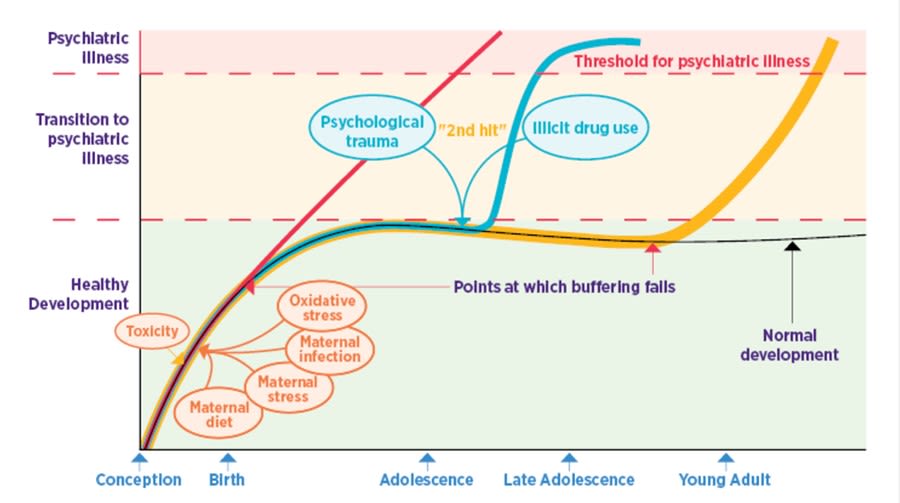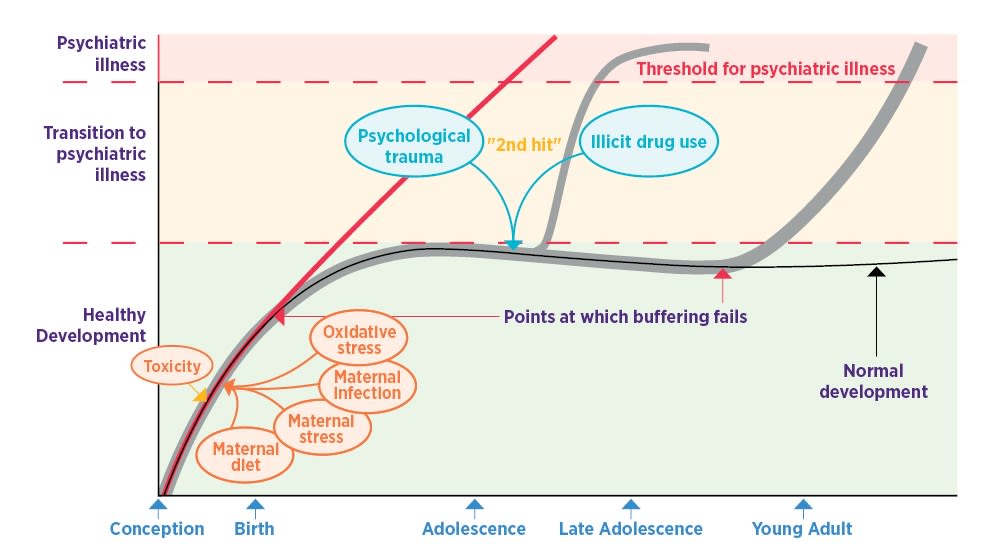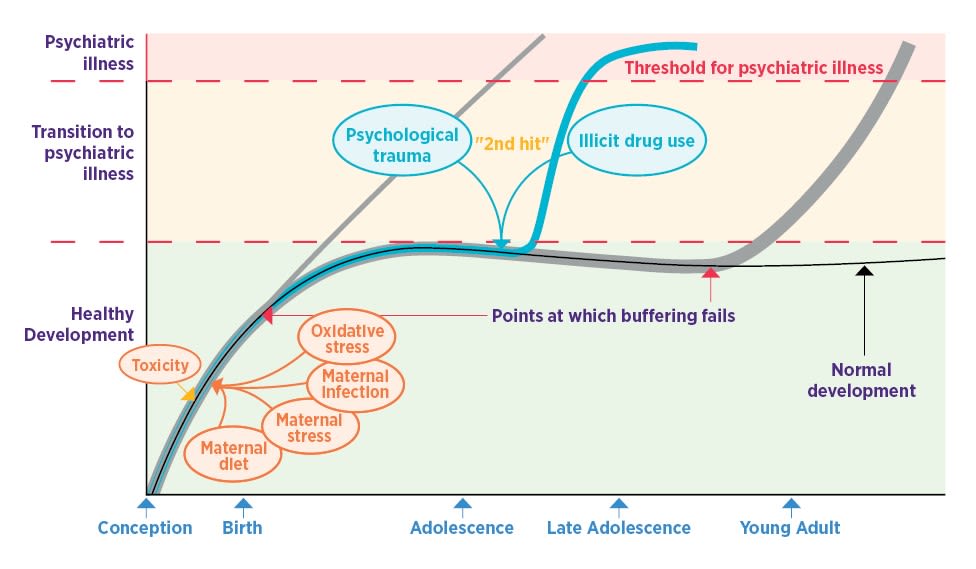Psychiatric conditions: when the brain can’t cope
The BRAIN magazine

While brains can, to some extent, adapt to environmental and genetic challenges during development in the womb, some cases, exposure to toxins, pathogens and other threats leads to the development of psychiatric conditions during childhood or adulthood.
Researchers propose that this occurs when the level of developmental insults reaches a certain threshold beyond which the developing brain can no longer adapt to the detrimental impacts it faces.

The three main pathways thought to lead to the emergence of psychiatric conditions. Source: Queensland Brain Institute
The three main pathways thought to lead to the emergence of psychiatric conditions. Source: Queensland Brain Institute
If adaptation fails before birth —for example, if the individual was genetically less resilient to insults —childhood psychiatric conditions such as autism or ADHD can emerge indicated by the red line in the infographic below.

The pathway to psychiatric conditions if adaptation fails before birth. Source: The Queensland Brain Institute
The pathway to psychiatric conditions if adaptation fails before birth. Source: The Queensland Brain Institute.
Alternatively, in cases where insults before birth were deflected, the use of illicit drugs, highly stressful life events, or a significant psychological trauma – for example, during adolescence – may trigger psychiatric conditions many years after the original insult occurred. This is the so-called ‘two-hit’ model, in which later stressors trigger a transition to psychiatric illness that had otherwise initially been successfully avoided by the developing brain’s buffering capacity as indicated by the blue line in the infographic below.

The ‘two-hit’ model, in which later stressors trigger a transition to psychiatric illness that had otherwise initially been successfully avoided by the developing brain’s buffering capacity. Source: The Queensland Brain Institute
The ‘two-hit’ model, in which later stressors trigger a transition to psychiatric illness that had otherwise initially been successfully avoided by the developing brain’s buffering capacity. Source: The Queensland Brain Institute.
A third possibility is that the effects of early events are initially masked by the developing brain’s ability to adapt but that this adaptation does not last forever. So, when brain circuits mature and become ‘hardwired’, an unintended consequence is that early adaptations to those early events become unmasked, crossing the threshold towards psychiatric conditions such as schizophrenia or bipolar disorder (see the yellow line in the infographic below). Hormonal surges during puberty can also impact this wiring process.

The pathway to psychiatric conditions when early events are initially masked by the brain's ability to adapt but this becomes unmasked in later life. Source: The Queensland Brain Institute
The pathway to psychiatric conditions when early events are initially masked by the brain's ability to adapt but this becomes unmasked in later life. Source: The Queensland Brain Institute.
Moreover, research conducted in the laboratory of QBI’s Professor Darryl Eyles is contributing to the idea that the brain may also overcompensate - i.e., by creating a toxic process that itself cannot be buffered at later developmental stages.
Disruptions in cortical development
The cortex is the outermost wrinkly layer of the brain and is the command and information processing centre responsible for consciousness, creativity, language, sensory perception and memory. Disruptions to the normal development of the cortex can happen at any embryonic stage and are caused by defective genes or disruptive or toxic environmental factors.
Alterations occur during a time when the brain is rapidly producing new neurons and as the new-born neurons migrate to different parts of the maturing brain. When this highly regulated process goes awry, too many or too few neurons are produced (micro- or macrocephaly, respectively), neurons cluster in the wrong place, or incorrect neuronal connections form, thereby disturbing neural circuitry and brain function.
The effects can be mild, with the brain adapting to this challenge, or can be severe, resulting in seizures, intellectual disability, significant impairment to movement and even contribute to neuropsychiatric disorders such as autism.
Researchers in the lab of Professor Helen Cooper at QBI study cortical disorders to discover why sometimes the correct number of neurons are not generated from stem cells, and why they fail to migrate to their specified brain region and establish functional circuitry.
Cortical development disorders can also disrupt the normal wiring of neurons in the developing brain. Once migrating cells reach their correct location, they then must wire properly for the brain to function well. Researchers like Dr Laura Fenlon and Dr Rodrigo Suarez study this process and how it goes wrong—for example, in disorders of the corpus callosum, the bridge of neurons connecting the left and right cerebral hemispheres. The symptoms are highly variable but can include sensory and motor problems and language and reading difficulties.
QBI researchers are now focusing on how such early impacts on the growing cells and circuits in the developing brain may help us discover pathways to psychiatric disorders.